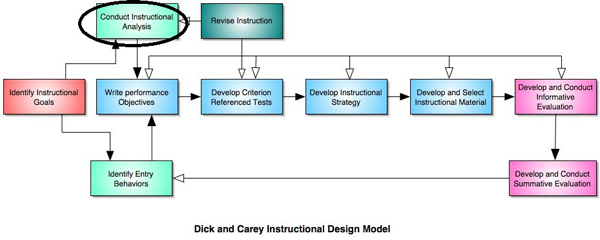Week Six Characteristics of Learners & Context
This Week February 18, 2013
This week, we'll:
- Analyze the target population of learners
- Study the context of the setting in which the learners will use their new skills
- Describe the context in which the instruction will be delivered
Learning Objectives
- Name the general characteristics of the target population that are important to consider when developing instruction.
- Name contextual characteristics of the eventual setting where acquired skills will be performed.
- Name contextual characteristics of the instructional setting.
- For a given instructinal goal and context, describe methods and sources for obtaining information about the target population, performance setting and learning setting.
- Analyze and describe the general characteristics of a target population.
- Analyze and describe the contextual characteristics of the eventual performance and instructional settings.
Why is this information important to the instructional designer? Here are three top reasons:
- All learners are not alike and will differ in the ways they learn best. Therefore, we need to take these differences, as well as similarities, into account because they will impact the instructional strategy that we select.
- Understanding the performance context, or the setting in which the new skills and knowledge will be used, will enhance the transfer of that new knowledge to the work place setting.
- Learning does not occur in a vacuum, so it is important to evaluate contextual factors that either inhibit or enhance learning.
As we all know from personal experience, seating arrangements, lighting, noise, and even temperature can affect our ability to learn a new skill. So, as a designer you must accommodate contextual factors that you cannot control or sometimes even adjust the instructional strategy to fit the context.
Your analysis of the target population for your instructional unit and the performance and instructional context is part 2.3 of assignment 2.
Use this rubric/heuristic to help identify the target characteristics of your learners and the learning context.
Study the visual representation of the Dick and Carey model (see p. 94). Note that the task of analyzing learners and contexts occurs simultaneously with analyzing the instructional context, even though these two steps are covered sequentially in the text book. In actual fact, you can perform these analysis tasks in any order, and you may have even gathered some the data on your target population during the needs assessment phase.

For more information on the role of context in learning and instructional design, I highly recommend the article by Tessmer and Richey which will help you understand the importance of learning context.
- Tessmer and Richey Part 1
- Tessmer and Richey Part 2
- Tessmer and Richey Part 3
- Tessmer and Richey Part 4
Think of it this way...before building a bridge or a car or a plane, engineers spend many months analyzing, designing, and reworking the design. Similarly, before actually developing instructional materials, instructional designers should go through a similar process. Unfortunately, the reality is that in many cases, in a corporate world, the analysis and design phases of the instructional design process are often skipped due to time constraints. And often, as with any poor design, the results may be less than optimal.
Required Reading
- Chapter 4
- Iris Daniels Case Study
- Tessmer/Richey articles above
Suggested Reading
Learner Analysis - a nice collection of links pertaining to this topic
Assignments
- Read the Iris Daniels Case Study. Be prepared to discuss learner contexts and characteristics.
- Analyze the general characteristics of your target population
- Analyze the performance context in which the new knowledge or skills will be used.
- Analyze the instructional context in which the instruction will be delivered.
- Complete Assignment 2 for peer review by Monday February 18
- Conduct Peer Reviews as follows:
- Heidi reviews Gail and Gail reviews Heidi
- Doris reviews Stormie and Stormie reviews Doris
Please complete and return peer reviews by Friday, February February 22.
Online Class Discussion
Monday, February 18, 8-9:30 p.m., Eastern time via Webex. I will send you the email login so that you can enter the class discussion.
Agenda:
- 8:00-8:10 Introductory discussion
- 8:10-8:45 Discussion of Iris Daniels Case Study -- be prepared to discuss learner context and characteristics
- 8:45-:920 Discussion of your instructional goals and potential subordinate skills -- be prepared
- 9:20-9:30 Preview of next week
Please email me with any questions.
Contact Me
codone_s@mercer.edu
Office: 478-301-4185
Dr. Grady's Rubric for Goal Analysis
An example of a Goal with Subordinate Skills in a flowchart
Student Examples (representing the final assignment 2 due Feb 18)